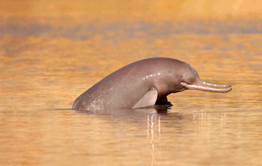

Context:
A recent publication by scientists and researchers has revealed that 19 Gangetic river dolphins had been rescued from the irrigation canals of the Ganga-Ghagra basin in Uttar Pradesh between 2013 and 2020.
Details about the publication:
- Titled‘Rescuing Ganges river dolphins (Platanista gangetica) from irrigation canals in Uttar Pradesh, North India, 2013–2020‘.
- The publication details about:
- Highlights the capture and relocation methods
- Describes the behavioral and demographic details of rescued animals and locations of these canals where the animals had been trapped
Key findings:
- 24 rescue operations had been conducted from 2013 to 2020 (19 successful rescue operations) and five dolphins had died.
- Dams and barrages had severely affected this habitat as dolphins moved into irrigation canals where they were at a risk of injury or death from multiple factors, such as rapidly receding waters, heat stroke and human interferences.
- The dolphins may either stray into the canal while following prey upstream or get flushed into the canal by a sudden discharge of water from the barrage gates.
- Over 70% of entrapments were reported either post monsoon or during peak winter.
About Ghagra River Basin
- The river begins on the southern slopes of the Himalayas in Tibet, in the Mapchachungo glaciers, at an elevation of about 3962 meters.
- The river flows south through Nepal as the Karnali River, passing through one of Nepal's most desolate and unexplored regions.
- The Seti River, which drains the western part of the catchment and joins the Karnali River in Doti north of Dundras Hill, is a 202-kilometer-long stream that feeds this river.
- The Bheri River, which runs for 264 kilometres through the eastern part of the Catchment and converges with the Karnali River near Kuineghat in Surkhet, is another feeder stream.
|
Key Facts:
|
Global efforts to protect dolphins:
- In 2016, the International Whaling Commission’s (IWC) scientific committee recognized that both Ganges and Indus river dolphins require prompt and coordinated action to protect them from imminent threats.
- In 2017, the IWC created the Asian River Dolphin Task Team (AR?TT) to identify information gaps and research priorities and develop concerted action for the protection of the Ganges and Indus river species in their range.
Ganges river dolphins (Platanista gangetica)

- The Ganges river dolphin can only live in freshwater and is essentially blind.
- They hunt by emitting ultrasonic sounds or by echolocation.
- They are frequently found alone or in small groups, and generally a mother and calf travel together.
- Females are larger than males and give birth once every two to three years to only one calf.
- Gangetic dolphins are the National aquatic animal of India.
- National Board for Wildlife (NBWL) has accorded the 5th October as National Dolphin Day in 2022.
- Conservation Status:
- The Ganges river dolphin is in;
- Schedule 1 of the Indian Wildlife (Protection) Act 1972,
- Appendix 1 of the Convention on International Trade in Endangered Species (CITES)
- Appendix 1 of the Convention on Migratory Species (CMS) and
- It is as “endangered” on the IUCN Red List.
- The Ganges river dolphin is in;



